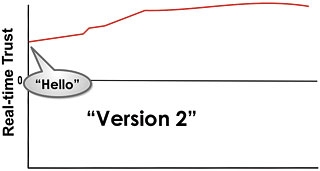Pop quiz question No. 1: What is the most common reason companies lose good, ongoing customer accounts? The normal responses to this are usually variations on a theme of neglect and taking the customer for granted. Nope!
While neglect certainly has contributed to many customer defections, it’s not the most common reason. The most common – at least statistically – is summed up in a single word: change! Some kind of change took place at the account that affected our business with them and we weren’t aware of it.
Pop quiz question No. 2: What is the most common reason that customers don’t share breakthrough information with us? Answer: because we haven’t given them enough reason to share it with us.

It’s not about the questions we ask or even how we ask the questions. It’s more about how we frame up the conversation itself. It’s about putting the customer’s mind in the right place for the conversation.
Position information exchange, not extraction
In other words, it’s about how we create an atmosphere of information exchange, not information extraction. Really simple, but not so easy.
We’re already at a certain bottom line here: our best accounts are vulnerable to defection because of our lack of knowledge of what’s going on behind the scenes – business, politics, etc.
The kind of information we need to stay truly plugged in to what’s happening at the account is never going to come to us organically, just as a result of being there. Nor are our best contacts going to consistently volunteer what we need to know.
We have to ask! In other words, we have to master the information gathering meeting.
The first step in that mastery is how we position the meeting with our contacts. This seems like it should be a straightforward conversation. It’s not.
Which trust curve would you rather travel?
Let’s look at two versions, along with their associated real-time trust curves, to see why.
Positioning an information gathering meeting: version 1
(See Figure 1)
“Al, as I said on the phone, what I’d like to do in today’s appointment is take a new approach. I’ve been calling on your account for a number of years now and you’ve always been an important contact for me. So what I’d like to do is, instead of talking about a lot of the things that we always talk about, I’d like to get some information and ask you some questions about XYZ business. We’re trying to do a better job of listening to our customers, and I think the better job that I do of understanding your needs the better job my company can do of bringing unique solutions to our relationship.”
Positioning an information gathering meeting: version 2
(See Figure 2)
“Al, as I said on the phone, what I’d like to do in today’s meeting is maybe go in a little bit different direction than we typically do. I’d like to leave some of our day-to-day stuff at the door so that I can take a step back and kind of go into homework mode to make sure I’m keeping my arms around the bigger picture business issues here at XYZ. I mean, clearly the better we continue to understand how you guys tick as a business, I think the better job we can continue to do of bringing value to the ongoing business relationship between our two companies.”
Where would you rather be a few minutes into your information gathering meeting: at the end of the version 1 trust curve or the version 2 curve?
Guess what? When given the choice between the two scripts – in the absence of their associated trust curves – almost 80 percent of salespeople choose version 1. “It’s more professional sounding than version 2,” is what most of them say.
You want to protect good current accounts? Then master information gathering. You want to master information gathering? Then master framing up the information gathering conversation.
The ultimate irony
Oh, and one last thing. Isn’t it ironic that, in a meeting dedicated to gaining information and asking questions, the words “information” and “ask you some questions” are among the most destructive to real-time trust?
Jerry Stapleton is the founder of Delafield-based Stapleton Resources LLC (www.stapletonresources.com). He is also the author of the book, “From Vendor to Business Resource.”


